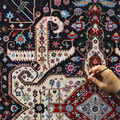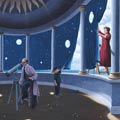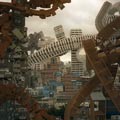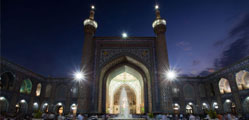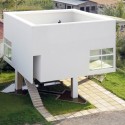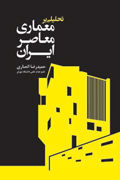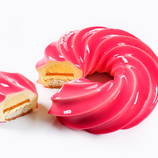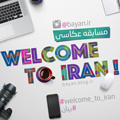یه سری کار نمادین کمونیستی که احتمالا تا حالا هیچ کدومش رو ندیدین! حداقل من اولین بارم بود
اونایی که حال دارن متن ش رو هم مطالعه کنن، نکات جالبی داره
برای اونایی که علاقه دارن به پیگیری هنر دوران مدرن و کانستراکتیویسم ، حتما جالبه
برا اونایی که علاقه دارن به مطالعه ی تاریخ بشر آموزنده ست
برا اونایی که علاقه به عبرت دارن و تدبر ، تذکره!
راستی به برخوردی که امروزه با آثار شده هم خیلی دقت کنین.... الدنیا دار العبر...

monument to the soviet army
As part of his series dealing with forgotten monuments from the communist era in
Bulgaria,
Nikola Mihov has shared with us his story and photos of the many iconic communist era monuments in
Bulgaria that were dismantled after the fall of the totalitarian regime in 1989. Nevertheless, more than one hundred important monuments built between 1945 and 1989 remain standing. The majority of these sites are not recognized by the state and they remain ownerless. Their exact number is unknown and it is difficult to find information about their authors and their history. More images and his story after the break.

monument to soviet army, Burgas, 1953
The graffiti "Forget Your Past" above the entrance of the Bulgarian Communist Party memorial demonstrates their faith. Situated in towns across the country, and once a symbol of pride, today most of communist era monuments are neglected and ransacked. Regardless of whether they were built to commemorate the Soviet Army or the struggle against Ottoman rule, they all share one and the same fate: to be a silent symbol of the forgotten past.
Nikola Mihov's photographic series "Forget Your Past" reveals 14 of the most significant communist era monuments in
Bulgaria. This project is realized within the support of Trace, a platform that brings together artists and architects to consider the integration of the communist monuments into the present day urban environment.

monument to soviet army, Burgas, 1953
Architect: Milko Milkov
Sculptors: Vasil Radoslavov, Aneta Atanasova
Height: 18 m
The Monument to the Soviet army is located in the city center of Burgas. It epitomizes a battle scene from World War II and the welcoming of the Red Army troops in the town of Burgas. After the fall of the Communist regime a heavy discussion regarding its future took place. Thousands of citizens signed a petition in favour of its demolition. Eventually, in 1993, according to an agreement between
Bulgaria and Russia, concerning the Russian monuments in
Bulgaria, the monument was put under protection and its future secured. Today it is one of the few well maintained monuments from the communist period, although swastikas are often scrawled on it.

monument to the soviet army, Plovdiv, 1954

monument to the soviet army, Plovdiv, 1954
Architects: Boris Markov, Petar Tzvetkov, Nikolay Marangozov
Sculptors: Vasil Radoslavov, Lubomir Dalchev, Georgi Kocev, Todor Bosilkov, Alexander Zankov
Height: 17 m
The Monument to the Soviet army was built on ''The Hill of the Liberators'' in Plovdiv . It epitomizes a battle scene from World War II and the welcoming of the Red Army troops in
Bulgaria. A 11 meter-high granite statue of a Soviet soldioer, named Alyosha, dominates the city skyline. An the bottom of the statue an inscription reads "Glory to the Invincible Soviet Army – liberator". The sculpture is made after a photograph of Alexey Skurlatov, a Soviet Army signalman who worked on the re-establishment of the telephone conetion between Plovdiv and Sofia in September 1944. His face can also be seen on some other monuments from the same period. In 1966 the soviet composer Edward Kolmanovski dedicated a song to the Alyosha's monument. This song became the official city anthem and Alexey Skurlatov was made an honorary citizen of Plovdiv. After the political changes the monument has survived two decrees ordering its demolition as a symbol of "Soviet occupation". In 1996 Russian veterans, living in
Bulgaria, threatened to set them on fire, if the monument was to be removed. However in 2007 official selebrations and fireworks marked the monument's 50th anniversary, a jubilee postage stamp was issued and Alexey Skurlatov was officaily invited to visit
Bulgaria.

monument of the resistance, Vidin, 1963

monument of the resistance, Vidin, 1963
Architect: Ivan Tatarov
Sculptors: Hristo Simeonov, Metodi Izmirliev, Ivan Petrov
Height: 24 m
The Monument of the Resistance is located on the Danube bank in the city of Vidin. It is dedicated to "the anti-fascist and anti-capitalist resistance" in
Bulgaria. On the same spot, stood a prison, where, on the 8th of September 1944, six Bulgarian partisans were hanged. The three sculpture compositions are dedicated to the communist uprising of September 1923, the Bulgarian partisan movement and "the victory of socialism" in 1944. After the political changes the monuments was abandoned. Today the it is coated with red paint and covered with scrawl. The ossuary, located in its rear part, has been plundered.

memorial complex hillock of fraternity, Plovdiv, 1974

memorial complex hillock of fraternity, Plovdiv, 1974
Architects: Lubomir Shinkov, Vladimir Rangelov
Sculptors: Lubomir Dalchev, Ana Dalcheva, Peter Atanasov
Height: 7.4 m
The ''Hillock of fraternity'' monument symbolizes a Thracian hillock. It reminds of a stone wreath from above. A 90m long sculpture composition inside the monument is dedicated to the Liberation of
Bulgaria from Ottoman rule, the The Unification of
Bulgaria, the Bulgarian partisan movement and "the victory of socialism" in 1944. Bones of partisans from Plovdiv region were placed inside the memorial complex, once it was finished. It was inaugurated on 9th September 1974 by the party leader Todor Zhivkov in honor of the 30th anniversary of the "socialist revolution'' in
Bulgaria. There were plans to connect the ''Hillock of fraternity'' memorial to the Soviet army monument in the town, through a spacious boulevard which would then be used to perform "festive rituals". Today the memorial is locked with chains and covered with scrawl. The eternal flame in the middle of the hall went out and was never relit The municipality is planning to repaint the monument due to the opening of a commercial center in the area.

monument of the three generations, Perushtitza, 1976

monument of the three generations, Perushtitza, 1976
Architects: Lubomir Chinkov, Vladimir Rangelov
Sculptor: Lubomir Dalchev
Height: 23 m
The Monument of the Three Generations dominates skyline of Perushtitza. It was built to commemorate the 100th anniversary of the April Uprising, which indirectly provoked the Liberation of
Bulgaria from Ottoman rule in 1878. A 70 meter-long sculpture composition celebrate the liberation movement of 1876, the communist uprising of September 1923 and the ''socialist revolution in
Bulgaria'' of September 1944. After the political changes the red star on the top of the monument's bell tower was removed. At the present time the monument is abandoned. A three tone bronze wreath covering the ossuary of the heroes has disappeared and the stairs leading to the monument are overgrown with weeds.

memorial complex apriltzi panagyurishte, 1976

memorial complex apriltzi panagyurishte, 1976
Architects: Bogdan Tomalevski, Ivan Nikolov
Sculptors: Dimitar Daskalov, Sekul Kroumov, Velitchko Minekov
Height: 13 m
''Apriltzi'' was the first memorial complex built in
Bulgaria. It is dedicated to the 100th anniversary of the April uprising of the Bulgarians against Ottoman rule. It was built on the ''Manyovo Bardo'' hill, near the town, where one of the bloodiest battles of the uprising took place. During the suppression of the insurrection, Perushtitza was burnt down and razed to the ground. Today the monument is scrawled with graffiti, reading: "Propaganda", "Nike", and "България над всичко 14/88" (
Bulgaria above all, 14/88 is a number with a neo-Nazi, white supremacist meaning). Currently the municipality is planning to invest 1,5 million Euro in the renewal of the monument and the creation of a sound-and-light show in order to transform the complex in a tourist attraction.

memorial complex the defenders of stara zagora, stara zagora, 1977

memorial complex the defenders of stara zagora, stara zagora, 1977
Architects: Bogomil Davidkov, Blagvest Valkov
Sculptor: Krum Damianov, Bojidar Kozarev
Height: 50 m
The "The Defenders of Stara Zagora" memorial complex was built for the 100th anniversary of the battle for Stara Zagora, one of the major battles in the Russo-Turkish War of 1877-78, which resulted in the liberation of
Bulgaria after 500 years of Ottoman rule. A sculptural composition representing five Bulgarian volunteers and a Russian officer glorifies the exploits of six Bulgarian volunteer units, which fought under the Russian command. One hundred steps take the visitor to a 50 meter-high
concrete structure that symbolizes the waving of "Samara banner". The flag was given to the Bulgarian volunteers by the citizens of the Russian city of Samara. After the political changes the monument was neglected. The eternal flame went out and was never relit; two of the sculptures are robbed of their bayonets. The metal railings, the lighting and the electric installation were also stolen. The surrounding park was set on fire on a couple of occasions. Some of the metal plates and marble blocks, used to cover the ground surrounding the monument, were either sold as scrap metal or used as gravestones. In 2001 the municipality reintroduced a security service to protect against further damage to the monument; it has spent 250.000 Euro to partly restore the site.

park monument of the Bulgarian soviet friendship, Varna, 1978

park monument of the Bulgarian soviet friendship, Varna, 1978

park monument of the Bulgarian soviet friendship, Varna, 1978
Architect: Kamen Goranov
Sculptors: Alyosha Kafedzhiyski, Evgeni Baramov
Height: 23m
The park-monument of the Bulgarian-Soviet friendship was built on the Turna tepe hill, the site where the Russian forces had its base before the successful attack on Varna during the Russian –Turkish War of 1828–1829. Constructed for 7 months with the help of 27 000 volunteers, the monument is made of 10 000 tons of
concrete and 1000 tons of armature iron. More than 20 000 trees were planted in the area surrounding the monument. During the night, the 7th symphony of Shostakovich used to be played on the public announcement system in the park. The 48m wide monument was illuminated by 180 spotlights, so it was visible from the sea – kilometers before reaching land. Soon after the political changes regime, in the beginning of 1990, the monument and the adjacent bookstore, bomb shelter and tourist office were abandoned. Today the eternal flame has disappeared, just like the massive bronze letters from the inscription reading "Friendship for centuries throughout centuries". The internal space of the monument, used for Communist party gatherings, is now used as a depot for used tyres.

monument banner of peace, Sofia, 1979

monument banner of peace, Sofia, 1979
Architect: Georgi Gechev
Sculptor: Krum Damianov
Height: 32 m
The monument ''Banner of Peace was built on the occasion of the first Children's Assembly "Banner of Peace", held in Sofia in 1979 in dedication to the International Year of the Child. About one hundred bells, brought from all over the world, were inset into the monument. The assembly was inaugurated by the director-general of UNESCO Amadou-Mahtar M'Bow. The initiative continued until 1989 under the motto "Unity, Creativity, Beauty". In its four editions a total of 19 000 children from 139 countries took part. Initiator of the "Banner of Peace" Movement was Ludmila Jivkova, daughter of the communist party leader Todor Jivkov, and Minister of Culture at the time. In August 1990 the foundation that organized the assembly was closed, the monument "Banner of Peace" was abandoned and some bells stolen. In 1999 a security service was reintroduced and the Children's Assembly was later carried out once again, but on a much smaller scale and without international participation.

arc of liberty, Beklemeto, 1980

arc of liberty, Beklemeto, 1980
Architect: Georgi Stoilov
Sculptor: Velichko Minekov
Height: 37 m
The Arc of Liberty is located at the highest point (1550 m) of the Troyan-Karnare pass in the Balkan Mountain. In a surprising strategic move during the Russian -Turkish War, the Russian army, under the command of Gen. Kartsov, took over the pass in January 1878 under extremely harsh weather conditions and with the help of local volunteers. Russia's victory in this war resulted in the liberation of
Bulgaria from Ottoman rule. The monument was dedicated to the Bulgarian-Russian brotherhood of arms, the ''anti-fascist resistance'' and the unity of the two periods in history. 7 meter high sculpture compositions symbolize the feats of the general Kartsov. Today the monument is scrawled with graffiti and its surroundings are desolate. The eternal flame went out and was never relit.

house monument of the Bulgarian communist party, mount buzludzha, 1981

house monument of the Bulgarian communist party, mount buzludzha, 1981

house monument of the Bulgarian communist party, mount buzludzha, 1981
Architect: Georgi Stoilov
Decorative artists: Velichko Minekov, Valentin Starchev, Vladislav Paskalev, Kantcho Kanev, Stoiu Todorov, Dimitar Boykov, Mihail Benchev, Ioan Leviev, Hristo Stefanov, Dimitar Kirov, Ivan Stoilov (Bunkera)
Height: 70 m
The House of the Bulgarian Communist Party is the largest monument in
Bulgaria. It is located on mount Buzludzha (1441 m) in the Balkan Mountain. It was erected for the 90th anniversary of the Buzludzha congress, where the Bulgarian Social-Democratic Workers' Party, the predecessor of the Bulgarian Communist Party, was founded. 16 million leva were collected as both voluntary and obligatory donations for the construction of the monument. Eventually, 14 186 000 leva were spent (approximately $ 13 500 000 of those days). The rest was spent on the construction of three kindergartens. It took military construction units almost seven years to complete the monument. Altogether more than 6000 workers and experts took part in the construction work. More than 20 leading Bulgarian artists, worked for 18 months in order to complete the interior decoration. Verses of "The International" and "The Worker's March" were inscribed on the entrance of of the meorial. The interior used to be partly covered in marble. The staircases were decorated with red cathedral glass. In the 15 meter-high main hall of the memorial a 500 sq.m. fresco present portraits of Marx, Engels, Lenin and the Bulgarian communist leader Todor Zhivkov. The dome of the structure was covered with thirty tones of cooper. Two 12m stars of ruby glass was built-in on the top of the 70m high pylon of the monument that symbolizes a waving communist flag. Buzludzha stars were made in the Soviet union, and they were three times bigger than those in Kremlin. The monument was inaugurated by Todor Zhivkov, himself. In a hole left deliberately in the building's walls, he laid a glass bottle that contained a message to the future generations, explaining the historical significance of Buzludzha. On 10th of November 1989 Zhivkov stepped down after 35 years in power. Immediately afterwards, Politburo ordered the removal of his portrait from the memorial. In 1991 the monument, which still belonged to the ex-communist party, was ceded to the state and was abandoned, looted and left to self-destruction.

monument founders of the Bulgarian state shumen, 1981

monument founders of the Bulgarian state shumen, 1981

monument founders of the Bulgarian state shumen, 1981
Architects: Georgi Gechev, Blagoi Atanasov
Sculptors: Krum Damianov, Ivan Savov
Painters: Vladislav Paskalev, Simeon Venov
Height: 52 m
The memorial complex ''Founders of the Bulgarian State'' is located on the top of a hill near Shumen, and it is visible from a distance of 30 km. It was built in 1981 to commemorate the 1300th anniversary of the Bulgarian State. 1300 steps take the visitor from the city centre to the monument. Eight
concrete blocks forming spiral symbolize the country's historic prosperity. Major events from the history of the First Bulgarian Empire (681 – 1018 A.D.) are represented by 21 monumental sculptures and a mosaic triptych – the biggest open-air mosaic in Europe. A giant lion statue was placed on the top of the monument. It is made of 2000 granite elements with a total weight of 1000 tonnes. The memorial has been visited by over two million people since its inauguration in 1981. Since 1992 it is even possible to hold a civil marriage there.

monument 1300 years
Bulgaria, Sofia, 1981

monument 1300 years
Bulgaria, Sofia, 1981
Architect: Alexander Barov, Atanas Agura, Vladimir Romenski
Sculptor: Valentin Starchev
Height: 32 m
The monument was built on the occasion of the 1300th anniversary of the foundation of the Bulgarian State. It was completed in a hurry (construction only took eight months), which resulted in low quality controls. The monument is located in the Sofia city center. Three intertwining structures symbolize the past, the present and the future. Four years after the inauguration, the marble plates covering the monument began to fall down. At the beginning of the 90's the memorial was completely abandoned by the authorities. In 2002 due to a visit of Pope John Paul II in Sofia, ot was enclosed by a security fence. Since then a public debate concerning its future has continued. Should it be demolished or renovated? At present the monument is completely covered by advertising billboards awaiting a renovation.

Pantheon of the heroes of the Serbo-Bulgarian war, Gurgulyat, 1985

Pantheon of the heroes of the Serbo-Bulgarian war, Gurgulyat, 1985
Architect: Georgi Stoilov
Sculptors: Boris Gondov, Todor Vardzhiev, Emil Mirchev
Height: 20 m
The Pantheon of the heroes is located near the village of Gurgulyat, a site of a major battle during the Serbo-Bulgarian war of 1885. The victory resulted in the international acknowledgement of the Unification of
Bulgaria. The red-
concrete memorial was built on occasion of the 100th anniversary of this historical event. The monument is in the shape of a pyramidal frustum, symbolizing the unity between heaven, where the souls of the fallen heroes rest, and earth, where there are bones are buried. The sculpture situated in the middle of the monument symbolizes Mother
Bulgaria, crying for her lost sons. It was made of red Quartzite stone, given as a present by the Soviet Union. The same stone was used in the Lenin Mausoleum in Moscow and the Napoleon's tomb in Paris. At present the monument is neglected. The bronze letter inscriptions paying homage to the heroes have disappeared and been replaced by plastic plates.




